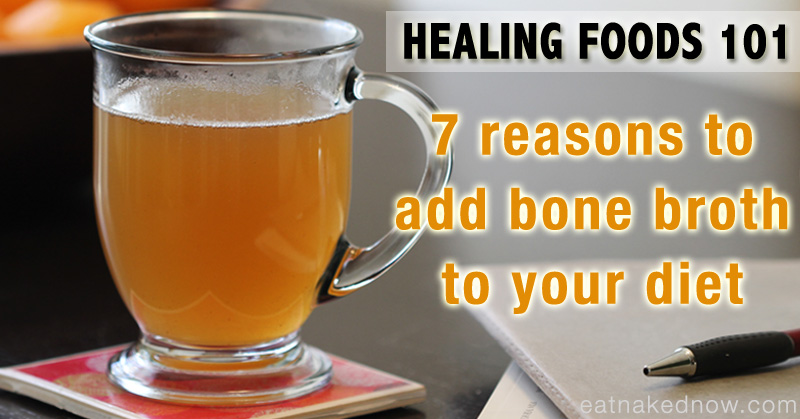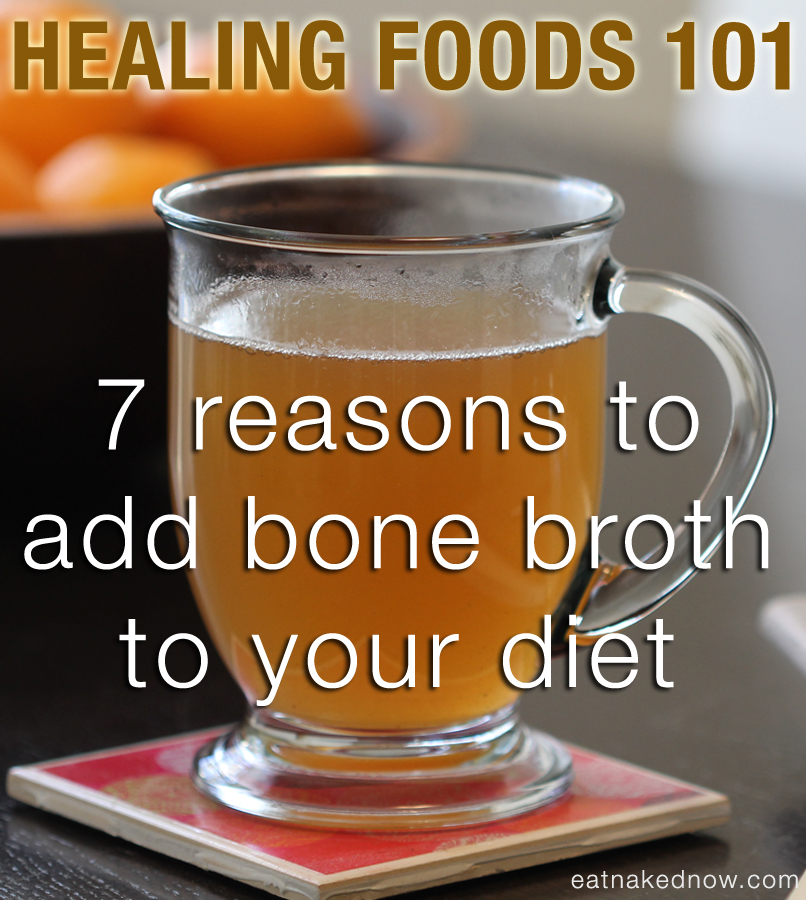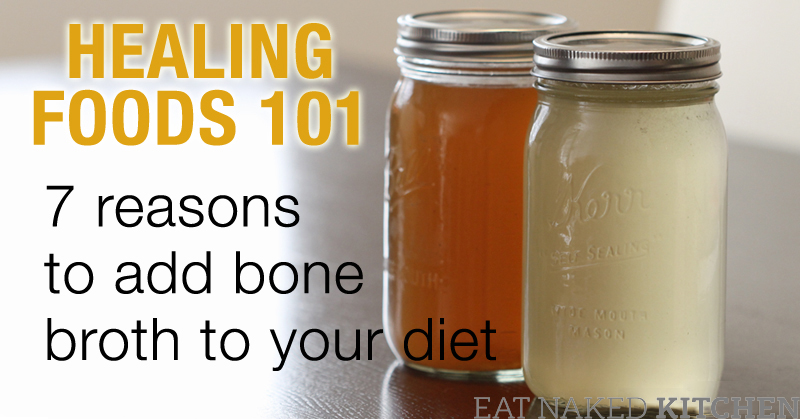When we talk about eating naked, we’re usually talking about the basics: eating real, whole food in a form that’s as close to its origin as possible, and prepared in a way that either preserves or enhances its nutritional value.
Now, I don’t like to discriminate, but there are some naked foods that are truly super foods, and bone broth is at the top of my list.
Bone broth – or “stock” as it’s sometimes called – is a cornerstone of traditional diets. We’ve been consuming broth in some form since Paleolithic times. And for good reason. It is powerfully healing, nutrient dense, and an efficient use of what has always been the most prized and expensive part of the human diet: animal foods.
Here are the top seven reasons why everyone should make bone broth a part of their daily diet:
1) It’s an excellent source of minerals – both macro minerals and trace minerals. The modern diet is woefully lacking in these vitally important nutrients, and bone broth is a dense source of them. If you don’t tolerate dairy, bone broth is an excellent source of calcium and magnesium.
2) It’s therapeutic for joints because it’s an excellent source of glucosamine and chondroitin, two of the more commonly self-prescribed supplements I see clients taking in my practice. Why pop another pill when you can get greater benefit from a real food?

3) The nutrients in bone broth are easily absorbable. This is no small deal. It’s one thing to consume nutrients – either through our diet (ideal) or through supplements (less than ideal, but sometimes the only option). It’s an entirely different thing for those nutrients to actually make it into our cells. The nutrients in bone broth are in a highly bioavailable format, so they get in there easily and without a lot of work from our digestive system. Speaking of which…
4) Bone broth is powerfully healing for the digestive system. This is in part due to its high content of gelatin, which helps to ease the digestion of cooked foods. Also, the nutrients in broth help to heal the lining of the digestive tract – one of the many reasons why it’s a foundational food in the increasingly popular therapeutic GAPS diet (Gut And Psychology Syndrome – we’ll be talking more about that in a later post).

5) Because it’s an excellent source of the amino acids arginine and glycine, broth reduces your need for protein. It is what we call “protein-sparing,” which means your body can make better use of the protein you do eat, thus not needing to eat as much. In fact, you can cut your meat consumption by as much as half if you include properly prepared bone broth as part of your daily diet. This is one of several reasons why…
6) …it’s extremely economical. I get tired of the “I can’t afford to eat healthy foods” argument against eating real food. Bone broth is an excellent example of how affordable it can be. As we just saw, it reduces your need for protein, which means you don’t need to eat as much meat. For another, it makes full use of the meat you do consume. All those bones and joints and bits and pieces we normally toss in the garbage are transformed into this nutrient-dense wonder. If you don’t have bones from your own meals to use, your butcher will sell them to you for next to nothing, since these are the parts they normally throw out. I recently heard one bone broth aficionado share that she can make a gallon of fish bone broth for $1.50. Beat that.
7) It makes food taste really, really good. Any soup, stew, or sauce made from a base of homemade broth is a very different thing from that made from broth out of a can, box, or (gasp!) from a bouillon cube diluted in water – no matter how “natural” or “organic” the package professes its contents to be.
So you see, there’s a reason we reach for the chicken noodle soup when we’re under the weather.
Here is a very simple formula for a basic bone broth. We also have several recipes for bone broths in the Naked Foods Cookbook. Broth takes time to make, but you need to be actively involved only for a very minimal amount of it.
What you’ll need:
- A large stock pot
- Several pounds of bones – these can be from scraps in your kitchen, the carcass from one or two roast chickens, or specially bought from your local butcher. Make sure you include the joints and ligaments – these are important.
- Veggie scraps (use onion peels and ends, garlic peels and ends, carrots, celery, peppers, etc – you can use just about anything that isn’t bitter). We like to throw in any veggies that are looking a little “sad” in our veggie bin at the end of the week – not moldy, but the ones looking a little to soggy to eat fresh.
- Very important: 1-2 teaspoons of vinegar. The acid helps to draws the minerals from the bones. You can use any type of vinegar.
- Optional: fresh herbs and spices. We’ll often throw in a few peppercorns, some fresh rosemary or sage, or other herbs that are floating around. Get creative! Once you’ve tried this a few times you’ll find what you like.
The process:
- Put the bones, veggie scraps, vinegar, and herbs into the stock pot. Cover with filtered water.
- Bring to a boil and skim any foam off the top. The foam is just any impurities coming out of the bones. Sometimes it’s there, sometimes it isn’t.
- Reduce the heat on your stove to the lowest possible and gently simmer your broth for at least 8 hours, up to 48 hours. The rule of thumb is the bigger the bones, the longer you need to simmer your broth. Make sure not to cook the broth at too high a temperature! It will denature some of the proteins and create natural MSG. We put the stove at the lowest temperature and just leave it for a couple of days.
- Strain out the bones and veggies, and either use immediately, or store in a big glass jar in your fridge. It keeps up to a week.
So you have a gallon of broth in your fridge. What now?
I drink it like I would a cup of tea every evening; sometimes multiple times a day. You can use it as base for soup, stews, pulled meats, or sauces. Use it instead of water for cooking grains such as rice, quinoa, or millet. If you make it gelatinous enough, you can cut it into cubes and eat it cold, like jell-o (fun and super nutritious food for kids!) And I’m sure there are plenty of other uses for it.
What are you waiting for? Grab some bones, dust off the big old stock pot, and get cooking!
More bone broth reading:
Everything you need to know about the benefits of bone broth by our friends and Oh Lardy!







I use broth when I make my children quinoa, it gives it a rich, complex flavor that they love. I use chicken or beef depending on what else I am serving and what I have in the freezer. .Also, when I make a bolognese where it calls for water I put in beef broth instead.
I read this while eating my breakfast of chicken soup made with homemade chicken stock (all made by my 19 yr old son), and I can hear the pot of beef stock simmering on the stove behind me! I already know a lot of this stuff, but I ALWAYS read all of your posts because there’s always one little gem I didn’t know. In this case, I didn’t know you could do damage with too high a temp! I thought boiling was boiling. I will be more careful!
My favorite use for broth, is of course, soup. But I’m a frequent eater, and if I have a 3 hr block when I know I won’t have a chance to eat, I put broth in one of those travel coffee mugs. It keeps it hot and I can sip on it while I’m working or doing errands until my next meal.
Good stuff!
W
Can you do this in a crockpot? I have a propane stove and just can’t see leaving it on that length of time, plus “low” is still quite hot. Thanks for the detailed recipe, I really want to try this!
BobbiJo – I’m not a crockpot expert, but if your crockpot can bring it to a boil and then a very low simmer, it’s fine to use it.
Yes! Crock pot broths are great. Just take note of what your pot is made of. We recently saw some crock pots with ceramic pots. That would be the healthiest option. Most commercial crock pots have aluminum or teflon coated pots. I wouldn’t recommend making bone broth (or anything for that matter) in those pots.
Great post! Reading this as my broth is simmering in the kitchen. Will add rosemary now! 😉 Mine has chicken back, carrots, celery, bay leaf and apple cider vinegar.
One thing that I make sure to add is salt. I don’t like things too salty, but I cannot drink broth without a touch of salt.
Cheers!
Hi Margaret,
I was also concerned when I read about too high a temp causing MSG from the denaturing of proteins. I did NOT know this! I have been canning my own stock using the pressure canner and this obviously is for the purpose of reaching high enough temps to kill botulism, etc. One of the very things I hated about off the shelf stocks and broths was the added MSG or Autolyzed yeast extract in the ingredients and here I was making my own MSG… live and learn. So I guess the best I can do is to FREEZE my stock? We have way to much to use in a week as we butcher about 25 chickens at a time. Thanks, K.
Kerry – Freezing it is the best way to store it. We let it cool and then store it in freezer bags. Just make sure they’re well sealed!
Hi Margaret,
This is a great article. It sums up many of the reasons people should be adding bone broth to their diets – regardless of whether or not they are healthy or sick. Bone Broth is true preventive medicine.
Please take a look at my website, where I’ve included a link to your article.
B
Hi, the way I make my broth is to boil it on the stove in a big pot, get it cooked down for about an hour and skimmed and then TRANSFER IT TO MY CROCKPOT ON HIGH where it cooks all day and or night, I just make sure the timing is such that I can strain and cool before I have to go to bed or out, its when its in the crockpot that I add all the herbs/spices. I also make a habit of breaking my bones either with a butcher knife or a hammer into smaller fragments to better make space as well as release nutrients
@Janeen – just be really careful about those high temperatures. You want your broth to simmer at low heat, otherwise you’ll create lots of MSG and damage delicate nutrients.
I have a beginner question/dilemma. I TRIED to make kitchen scrap stock last night and when I woke up I have a dried up pot. I had the stove on low (never simmered at all at this temp is that ok) and at the 10 hr mark when I checked it was bone dry. I have all my bones to make beef bone stock and DO NOT want to mess this up. What did I do wrong 🙁 thank you
Hi Kathy,
It sounds like you either didn’t have enough water or that you need to turn the stove down lower, or a combo of the two. When you say it never simmered, do you mean it was always boiling? You definitely want it to go to a very low simmer, otherwise it creates too much MSG (so maybe it’s a good thing it boiled all the way down to nothing!) Make sure the water goes almost the whole way up to the top (leave an inch or two so it doesn’t boil over) and make sure once it boils you turn it down to your stove’s lowest setting?
Let us know how it goes! ~Margaret
Margaret
I put the ten cups in, will do more next time, and I ment that my lowest setting never simmered just “sat” was hot but not enough to simmer by any means so the heat was very very minima and it still dried all up. Is that low of a heat what I was after? Thanks so very much for helping this extreme newby 🙂
Hi Kathy, you can also try leaving the lid on. Still ensure you have adequate amounts of water and maybe start it during the late evening so you can check it before going to bed. It’s possible your stovetop runs hotter than it says. All ovens are calibrated differently. If you keep having this problem, try using a heavier bottomed pot. There are also defusers that can be purchased that go between the stovetop and the pot. Looks like a metal plate with holes in it to help the pot from getting too hot. Keep us posted through your trials to let us know if you find success!
Hi there!
I made bone broth for the first time recently using bigger beef marrow bones. The broth is done and it’s delicious. I have the big stock pot sitting on my stove on the lowest heat setting.
I’m wondering if it’s possible to keep this pot where it is? As I take some stock out to consume, I add more water and a bit of vinegar to keep the bones going. Will the stock still go bad or become denatured if I just leave it and use it regularly? The bones are not soft yet so they continue to dissolve minerals.
Hi Robert,
Do you mean to keep the broth on simmer indefinitely until the bones are done? If so, that shouldn’t be an issue. I wouldn’t go more than three days though. The broth will get weaker and weaker as you take out stock and add water. Just make sure it isn’t boiling at any time. Natural MSG (which is not desired) is created from the boiling. Also, it is very rewarding allowing your broth to cool into gelatin. You know you made a good batch when it does.
So, what exactly are the “impurities” in the foam that rises to the top? Is it absolutely necessary to skim? I’ve been making it in the crock pot, and not skimming it.
I’ve always made my own stock from turkey carcasses/giblets for gravy, because it tastes delicious. Had no idea that it’s so healthy too, or that I should add a little vinegar to draw out the minerals! Now I’ll start making broth from alllll my bones lol. You mentioned it’s good for about a week…what about freezing? Are the nutrients lost or preserved?
Holly, freezing is a great way to make broth last. That’s what we do if we’ve made more than we can go through quickly. Freezing preserves all the nutrients and does the least amount of damage. Just make sure it has already cooled before you put it into the freezer.
I would be interested in pressure canning this for storage that doesnt require electricity. It would need 90 mins. You mentioned that high heat can cause it to turn to MSG?! Does this mean it isnt possible to can bone broth?
Thanks!!
Hi Misti, I’m not an expert in canning, but I think that since it requires high heat for such a long duration of time, you’d certainly be creating more MSG. I don’t exactly how much, though. That would require some testing. I like your idea of storing it without electricity, though. I’m just not sure how that would work.
Great post. I know this question will be difficult to answer, but about how much protein ins cup of bone broth? Thanks
That’s an excellent question and hard to answer. I did a little digging, and the closest I could find was this data on fish broth: http://nutritiondata.self.com/facts/soups-sauces-and-gravies/7236/2. But this doesn’t distinguish between homemade and commercially prepared (and in my opinion, commercially prepared usually compromises on quality and nutrient density…) I couldn’t find anything for bone or chicken broth that wasn’t in a soup with other ingredients or from bouillon cubes, which are a totally different thing.
Hi Jack, Thought I’d add my two cents around bone broth. The amount of meat on the bones when making bone broth is different every time so I wouldn’t rely on any Nutritional Data info on traditional, homemade bone broth (not that nutritional data exists for it anyway, as Margaret mentioned). I tend to focus on the nutrient-density of the broth and our ability to absorb those very available nutrients! Glad you discovered Eat Naked! Keep the comments coming! Cheers.
Thank for your respond! Just discovered your site and I love it!
Jack
Where is the science? I really want to see a citation where it says that high temps can create MSG. I’m not just taking your word for it – I want proof.
I can attest that natural MSG is released in bone broth, for those of us that are supper sensitive it is obvious. I was having a reaction and couldn’t figure it out until I realized it was from the bone broth. I use large bones and like to cook them for at least 12 hrs. I have not tested to see if I can drink it at 3 hrs. I will check in the future. I would also like to see “proof” but only to determine If i should even have it at 3 hrs not to see if it is there. We know that it is naturally in food and cooking releases it. Commercial cooking just releases more because of the temperature, cooking times and the hydrochloric acid used in the hydrolysis of vegetable proteins and bones in the manufacturing process.
Yes, please explain the MSG thing?? I don’t understand how heating broth is going to create MSG. I thought that MSG additives in food were processed salt concentrations. Please qualify your statement with some clarity for us need to know’s. Thanks.
I second this question, and a little bit surprised it was never answered?
I am skeptical of this little factoid…what is the mechanism behind this supposed MSG formation?
Thank Chef James!
When my broth is done, I like to reduce it by 2/3rds or so and then let it cool. Then I ladle what the French call the “glacé”, which literally means the reduced stock, into ice cube trays. Then I freeze them and when frozen, I break them out of the trays and put them in a zip lock bag in the freezer. From there I can use them like buillon cubes or add water to make stock for soup.
Excellent tip, @Rachel!
Is it necessary to actually bring the stock to a boil first? I love using my slow cooker to make broth, but it doesn’t boil, rather just stays at a great low simmer.
Hi, good article. I am also curious about the MSG. I have never heard this. If this is so, does that also happen when making soups etc with the broth. I use broth to make pasta also…ugh I’m concerned. I can all my broth and have about 100 quarts right now so this is very worrisome. Thanks.
Jennifer, it doesn’t make a lot of sense to me either. For example, pasta itself has protein in it and most people boil it to cook. Are there studies that show that msg is created if boiling meat and bones?
This is how I make my bone soup: I saute the bones to brown them, and then bake them till brown. Then I putnin a pressure cooker for 4 hours with vinegar, salt, herbs and veges. After that I strain it and keep it in the fridge when cooled next day I scoop out the fat, then use it as I like. Any comments on Pressure cooker cooking?
I too am very concerened to understand exactly how and when what foods develops msg when boiled and of course especially with broth. I always understood that if you left your broth to cool over night it was safer to bring it back to a boil before simmering it again.
So would you not even bring your broth to a boil at the very outset? With the new ceramic stoves it is so much harder to simmer things but wondering if the crock pot linings are safe.
And any research links would be appreciated.
To respond to your question about boiling creating MSG: Glutamic acid is a naturally-occurring amino acid that is present in a lot of foods, bone broth included. It is what’s responsible for that taste of “umami” that we love so much. In its natural form, it’s found bound to other proteins – when those protein bonds break (as they can with cooking) it creates the free form. The isolated form of glutamic acid – MSG – is what food manufacturers use in great amounts (far higher than you’d ever find naturally) to enhance the flavor of foods. When we recommend not boiling the broth, we’re talking about not boiling it over a long period of time. We do bring it to a boil briefly, but then turn it down immediately so as to reduce the formation of more unbound glutamic acid. I changed the wording to include “natural” because I can see on reading it how it could cause confusion the way it was written.
I have never made bone broth before and am just wondering: do you really leave your oven on overnight?
I feel a little nervous doing that. Can I turn it off at night, then get it back to a boil/simmer the next morning?
Thanks for any advice you have for me:)
You know, we do leave ours on overnight – often for up to 72hrs in a row. AND: we’re probably playing with fire (literally). The stove is on the absolute lowest setting and the broth is just on such a low simmer that we’re comfortable with it. Use your own judgment here. I would be concerned with turning it off completely that it would come up to a temperature that would allow bacteria and other pathogens to contaminate it…
I just made my first pot of bone broth. I laddled the broth off the top and strained it into mason jars which I let cool on the counter. Then put in the frig. The fat on top was soft and it was not gelatinous. I used beef neck bones and marrow bones and apple cider vinegar. I brought to a boil and simmered 48 hours. What did I do wrong?
You might try a different mix of bones, and you can try cooking it for a longer time. Sometimes ours isn’t gelatinous either – so we’ve extended the cooking time to 72hrs. I’m curious about the fat being soft, though… what temperature is your fridge? Usually the fat gets quite hard. I’d recommend keeping your fridge at 37 or 38 degrees.
I wouldn’t leave to cool on a counter. Bacteria being the reason
It’s perfectly safe to let it cool, uncovered, to room temperature and then refrigerate it. In fact that’s the safest way to cool a food.
Thank you for your reply. My frig settings are 1-5 and not degrees but it was set at the highest so I put it on 3. I am going to take your suggestions and try again.
I just made bone broth for the second time this past weekend. I got soup bones from my butcher shop (they were actually huge) and I browned them in the oven, then moved them to my 6 court crock pot where I simmered them for 24 hours. I added water twice, as it got about 2 inches from the top. I moved it to a large mixing bowl where it is now sitting with about 1/2 inch of congealed fat. I assume I can scrape that off and use it for cooking, but here is my question: my broth is congealed and gelatinous. Isn’t it supposed to be liquid like in your pictures? Is it too concentrated? If so, how much water can I add to it? Is it just by taste? I am afraid of diluting it too much and losing flavor, but I don’t want to waste all my bones and all the effort I put into it. Thanks.
@Tess – you did exactly the right thing and gelatinous congealed broth is AMAZING! It means it’s high in gelatin content, which the ones in these photos are as well, they just look liquid (if you opened the jar and dipped a spoon in, you’d find it’s like jello when it’s cold). Don’t do a thing to it other than heat it up and enjoy. And be proud of yourself for making such great broth!
Oh, and yes, the fat on top is great for cooking. Particularly cooking at high temperatures. It’s actually beef tallow. We use it for all sorts of things. Nice job!!
Hi is there an alternative to this if you are a vegetarian? Thanks
Tracy, you can make a veggie stock using egg shells to provide the minerals. It’s not as nutrient-dense by any means, but it’s a step in the right direction!
Thank you for the informative article. Can you point me to research supporting the statement that cooking the broth at too high a temperature will denature some of the proteins and create natural MSG? Thank you. I have read many articles stating that healthy bone broth can be made using pressure cookers/canners.